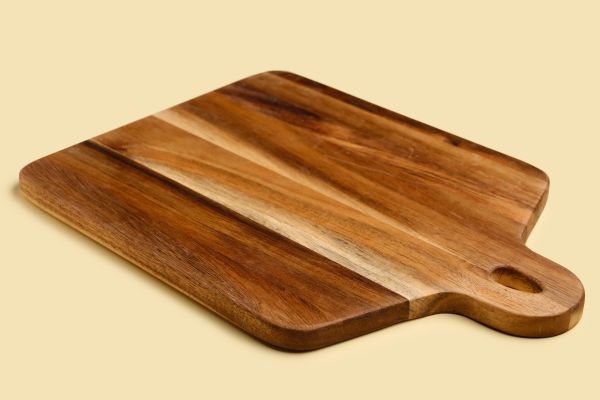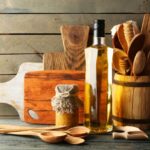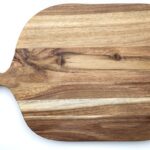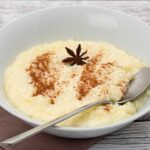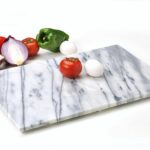The light and finely-grained maple wood is easy to recognize. Maple is native to the United States and Canada, but some species are also found in Europe. Hard maple or sugar maple is the wood most commonly used for manufacturing cutting boards.
Is Maple Wood Good for Cutting Boards?
The maple cutting board is by far the most popular wooden cutting board. Hard maple wood is considered the most suitable wood for the cutting board. There are multiple reasons for this:
Durable: Closed grain and small pores of maple wood make it more scratch and moisture-resistant than other woods and ensure a long-lasting cutting board surface.
Knife-friendly: Maple has just the right hardness. This wood is hard enough to provide clean cuts, but it’s also not so hard that your knife blades will quickly become dull.
Hygienic: Its dense closed grain prevents liquid or bacteria from entering the cutting surface. The National Sanitation Foundation (NSF) has approved maple for use in commercial kitchens. It is the perfect choice for customers who care about safety.
Elegant: Maple wood has a light color and a subtle grain. This stylish cutting board is an excellent addition to most kitchens. Due to its elegant, light finish, you can use it as a cheese serving tray.
Affordable: Maple cutting boards are relatively affordable because maple wood is widely available in the United States.
Downside
Light-colored wood like maple can easily stain.

Maple Cutting Board Care
To protect the food from contamination, you need to keep maple wood cutting boards clean. Maple cutting boards are easy to wash and dry due to their closed grain. However, because of the light color, maple wood cutting boards are prone to permanent stains. To reduce the possibility of stains you must wash the board immediately after each use. Wash the board with soapy water and rinse with warm water. Dry the board thoroughly with a clean dish towel and store it in a dry place. Leave it upright to minimize the risk of moisture entrapment. Avoid soaking it as maple cutting boards do not tolerate excessive moisture.
What Is the Best Finish for Maple Cutting Board?
- Mineral Oil
It is important to oil it regularly to preserve the beauty of a maple cutting board and prevent the wood from cracking and warping.
The best oil for conditioning maple cutting boards is food-grade mineral oil (link to Amazon). Apply mineral oil with a clean cloth and spread it evenly over the board. Let it sit for a few hours, then wipe the board and remove the excess oil with a clean cloth.
2. Combination of Beeswax and Mineral Oil
The combination of mineral oil and beeswax is ideal for conditioning wooden cutting boards. Add ¼ cup of beeswax to 1 cup of mineral oil and stir over low heat until the beeswax dissolves. Pour this mixture into a jar and let it sit for several hours. Then apply the paste to the cutting board with a clean cloth and leave it to work for about 15 minutes. Wipe the board with a clean cloth using a circular motion until the surface is smooth. Avoid vegetable and nut oils as they tend to go rancid. The board would then take on an unpleasant smell that could be transferred to the food.
Maple vs. Walnut Cutting Board
Both cutting boards are made from hardwood grown in the USA. Maple and walnut are among the best materials for making cutting boards. Both wood and wood are strong, durable, and visually appealing.
Durability: Compared to walnut wood, maple is denser and more moisture resistant. For this reason, maple cutting boards are less likely to warp or crack. Walnut wood has poor moisture resistance but hides cut marks better than maple. Due to the light color, the marks of the knife on the maple are more visible.
Appearance: Many people find that black walnut looks more attractive than maple. Walnut wood is deep brown with intricate grain patterns. A layer of oil makes it shinier and more beautiful. Maple, on the other hand, is more subtle and fits easily into any kitchen.
Antimicrobial properties: Both cutting boards possess antimicrobial properties. Maple is denser and more resistant to moisture and bacteria. The closed grain and small pores mean that microbes are less likely to grow and multiply. Walnut wood is less effective at blocking microbes.
Toxicity: Maple is naturally food and allergy-safe. On the other hand, walnut cutting boards can trigger a nut allergy due to the toxic juglone in walnut wood. If juglone comes into contact with food, an allergic reaction may occur. Walnut wood allergy is rare and mainly affects woodworkers. However, if you are concerned about allergic reactions, it is best to avoid contact with kitchen items made of walnut wood.
Hardness Rating: On the Janka hardness scale hard maple is 1450 while black walnut rates 1010. Walnut is a softer wood than maple, and therefore more knife-friendly. Maple is harder but not so hard that it dulls knife edges.
Maintenance: Walnut and maple wood cutting boards are low maintenance. These cutting boards are easy to clean and maintain and require periodical oiling to stay in good condition. Maple is more prone to staining. The rich, dark walnut tone can effectively cover up stains.
Customization: If you want to add a personal note to your gift to make it special, choose a maple cutting board. The engraved personalization is easily visible and looks great on the light maple wood surface.
Price: Maple is more abundant in the United States and is generally cheaper than walnut. Because of their beautiful appearance, walnut cutting boards are the most expensive. However, despite the cheaper price, maple cutting boards are generally slightly higher quality than walnut boards.
